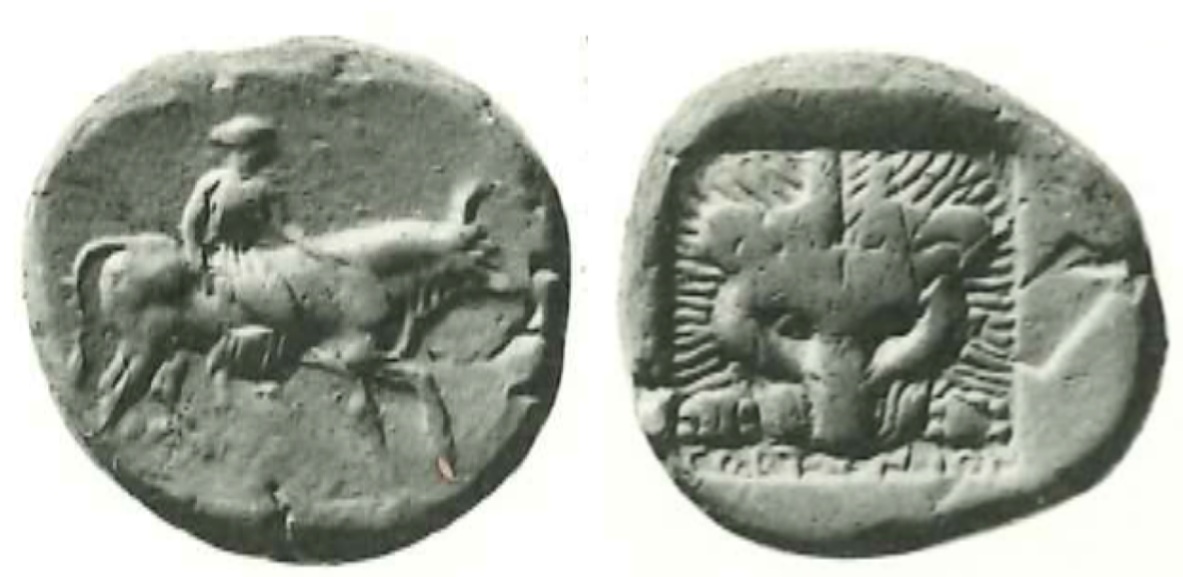29030 - Gortyn (stater Europa/bull) over Aegina (turtle/incuse square) (New York, ANS, Newell coll. - Le Rider 1966, pl. XI, 12)
From SILVER
470 BCE - 425 BCE
Location/history
| Museum collectionMuseum collection: | New York, ANS, E.T. Newell | Sale(s)Sale(s) ᵖ: | Naville, XII, 1614 |
Overstriking coin
Description
| ObverseInscription or printing placed on the obverse.: | Europa seated on bull right. | ReverseInscription or printing placed on the reverse.: | Head of lion facing within incuse square |
Mint and issuing power
| MintIdentifies the place of manufacture or issue of a numismatic object.: | Gortyn | Ancient regionAncient region. | Crete | Modern countryModern country: Greece | AuthorityIdentifies the issuing power. The authority can be "pretended" when the name or the portrait of X is on the coin but he/she was not the issuing power. It can also be "uncertain" when there is no mention of X on the coin but he/she was the issuing power according to the historical sources: |
Chronology
| FromIdentifies the initial date in a range assigned in a numismatic context. 470 BCE toIdentifies the final date in a range assigned in a numismatic context.. 425 BCE | Classical 480-323 BC |
Physical description
| MetalThe physical material (usually metal) from which an object is made.: Silver |
WeightWeight of the numismatic object (in grams). in grams: 11.8711.87 g <br />11,870 mg <br /> | DenominationTerm indicating the value of a numismatic object. Examples: tetradrachm, chalkous, denarius.: stater |
|
References
| Coin referenceReference of the Coin: | Le Rider 1966, p. 55, pl. XI, n° 12 | Coin series referenceReference to coin series study: | Le Rider 19661Le Rider 1966, p. 55, pl. XI, n° 12 |
| Coin series web referenceCoin series web references: | |||
Overstruck type
Description
| ObverseInscription or printing placed on the obverse.: | Turtle | ReverseInscription or printing placed on the reverse.: | Incuse square (windmill shape) |
Mint and issuing power
| MintIdentifies the place of manufacture or issue of a numismatic object. ᵖ: | Aegina | Ancient regionAncient region. ᵖ | Attica | Modern countryModern country: Greece | AuthorityIdentifies the authority in whose name (explicitly or implicitly) a numismatic object was issued. ᵖ: |
Chronology
| FromIdentifies the initial date in a range assigned in a numismatic context. 500 BCE toIdentifies the final date in a range assigned in a numismatic context.. 480 BCE | Archaic until 480 BC |
Physical description
| DenominationTerm indicating the value of a numismatic object. Examples: tetradrachm, chalkous, denarius. ᵖ: | stater |
StandardStandard. ᵖ: | Aeginetic |
References
| Coin type referenceReference to coin series study ᵖ: | BMC Attica2BMC Attica, Meadows (forthcoming)3Meadows (forthcoming) | ||
| Coin series web reference overstruckCoin series web references overstruck: | |||
Additional data
| Frequency of overstrikesFrequency of overstrikes: | frequent | Level of confidenceLevel of confidence of the identification: | sure |
| RemarksRemarks: | |||
References
- ^ Le Rider, Georges (1966), Monnaies crétoises du Ve au Ier siècle av. J.-C., Paris, Geuthner, 345 p. and 42 pl.
- ^ Head, V. Barclay (1888), British Museum. A Catalogue of the Greek coins in the British Museum. vol. VII : Attica - Megaris - Aegina, London, lxix, p.174 pl., 25.
- ^ Meadows, Andrew (forthcoming), Greek coinage in the Persian Empire: The Malayer 1934 Hoard (IGCH 1790).

